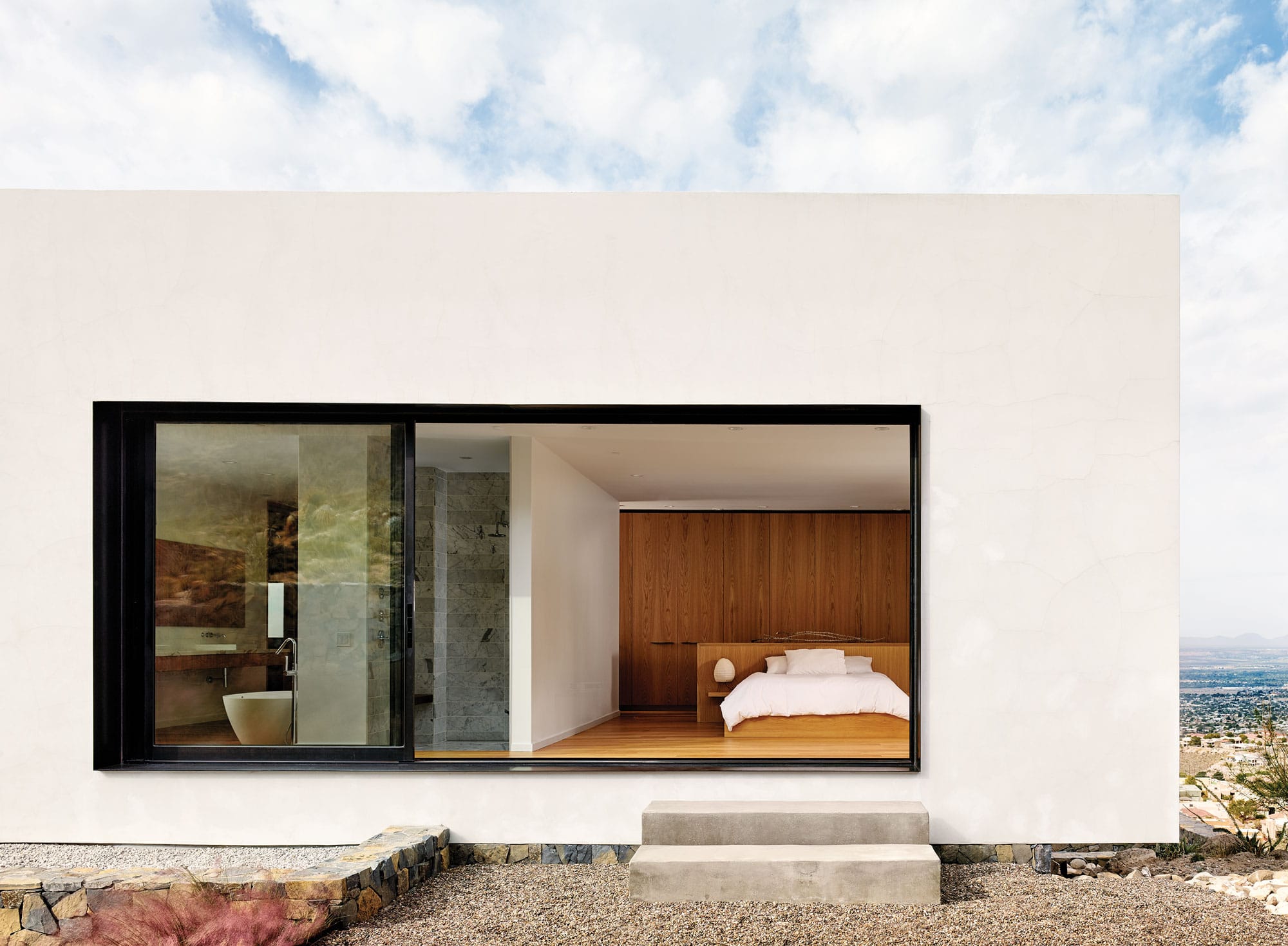The West Texas home sits on a hill in three stacked volumes with expansive windows. Photo by Casey Dunn
A building is a compromise. Take windows, for instance. A designer might envision a light-filled box of glass, only a fine line separating inside from out. It’s a beautiful vision, but sooner or later it will be confronted by the realities of the physical world: How large can a panel of glass be before it weakens and breaks? How far can you shave down the window frame before it’s too thin to support that glass? Will the glass box stay cool in the summer and warm in the winter? Will it be sustainable? Will it meet energy-efficiency regulations?
That’s where Western Window Systems comes in. For almost six decades, the Phoenix-based company has been bridging the gap between imagination and reality with its innovative door systems and windows. The company’s products give architects the tools to design homes with abundant natural light, all while keeping the homes as energy-efficient as possible.
In recent years, Western Window Systems has responded to the demand of designers of contemporary architecture for increasingly large sheets of glass, pushing the limits of width and height with each new product line. Today, a multi-slide door system—a wall of glass that slides open to merge the inside of the home with its environs—can be upward of 14 feet tall. Windows can stretch to 10 feet. “Other manufacturers just don’t do that,” says Ty Cranford, architectural director for Western Window Systems.
The company’s newest product line, the Series 7000, is designed with the energy consumption and structural requirements of numerous regions of the country in mind. The advanced strength and performance of the new family of moving glass walls and windows, launching throughout 2017, make them suitable in any climate where indoor-outdoor living is a priority while maintaining Western Window Systems’ usual slim profile and eye-catching expanses of glass. The company has grown by 50% every year for the last five years, and it’s these kinds of advances in technology that have fueled the exploding demand for its products—vast walls of glass needn’t be limited to California’s mild climate anymore. “We’ve learned that everyone wants to live this way,” Cranford says. “They want to let the outside in.”
Letting the Outdoors In
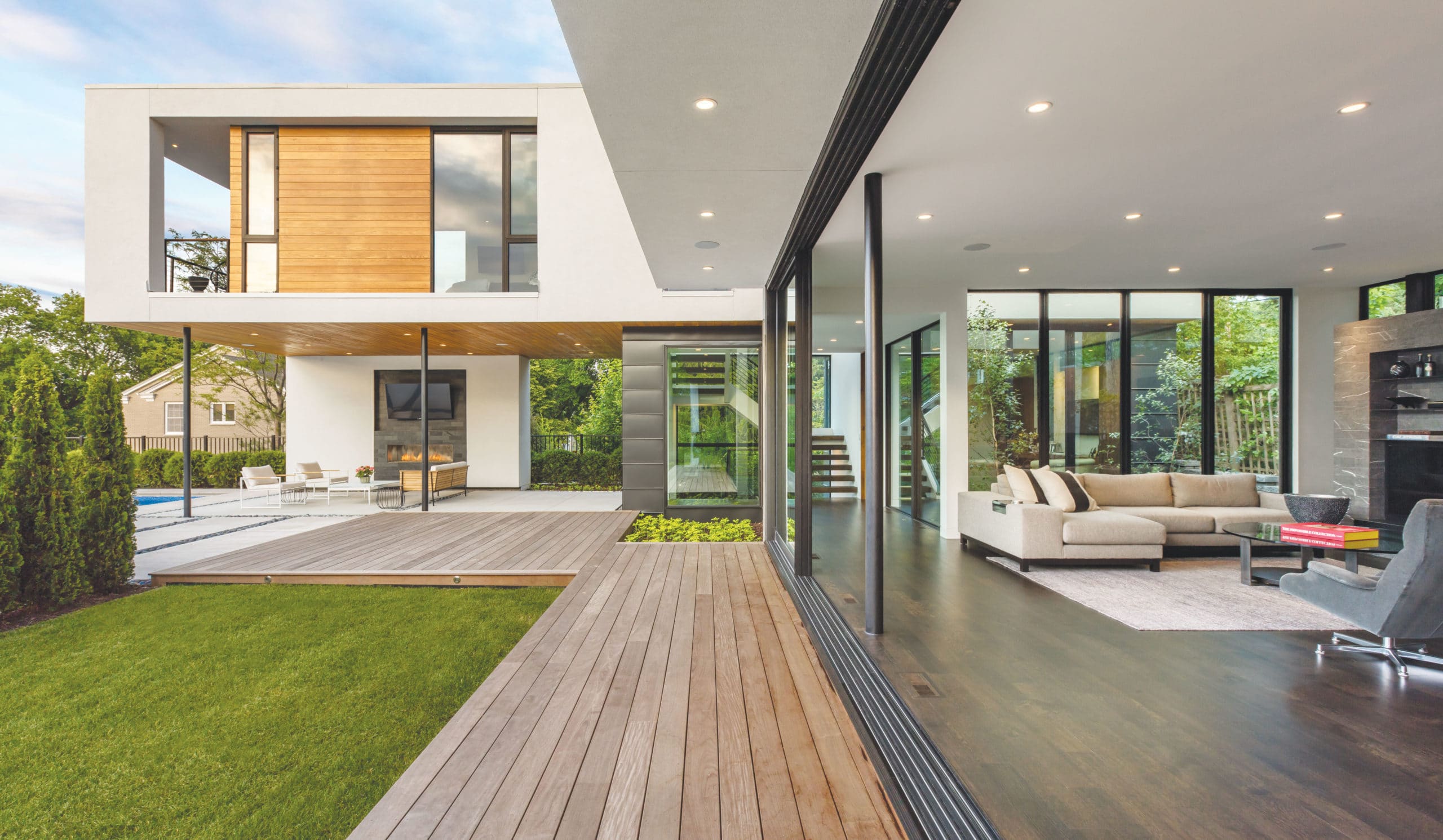
This Minnesota residence is filled with natural light let in by innovative window solutions. Photo by Paul Crosby
One technique for creating a light-filled building is to craft a narrow structure, so light from two sides is able to penetrate the entire space. The Calhoun Pavilions, designed by Minneapolis-based firm Peterssen/Keller Architecture, did just that, but multiplied by three. The firm’s clients, architecture-loving empty-nesters looking for a new home for the next phase of their lives, came to Peterssen/Keller with an unusual L-shaped lot that rises up from the street, offering views of Lake Calhoun and the Minneapolis skyline. They asked for a contemporary home that would make the most of natural light and seamlessly transition between inside and out.
The resulting residence consists of three pavilions enclosing a private courtyard, with glass-walled lightwells connecting the pavilions and brightening the lower levels. The first pavilion houses a two-car garage. The second holds guest rooms and an office, plus an integrated kitchen, living room, and dining room, where a whopping 23-foot-long Series 600 Multi-Slide Door from Western Window Systems opens onto the outdoor patio. The master suite is in the third pavilion, which sits on cantilevers over the courtyard and features stunning views of the lake and beyond.
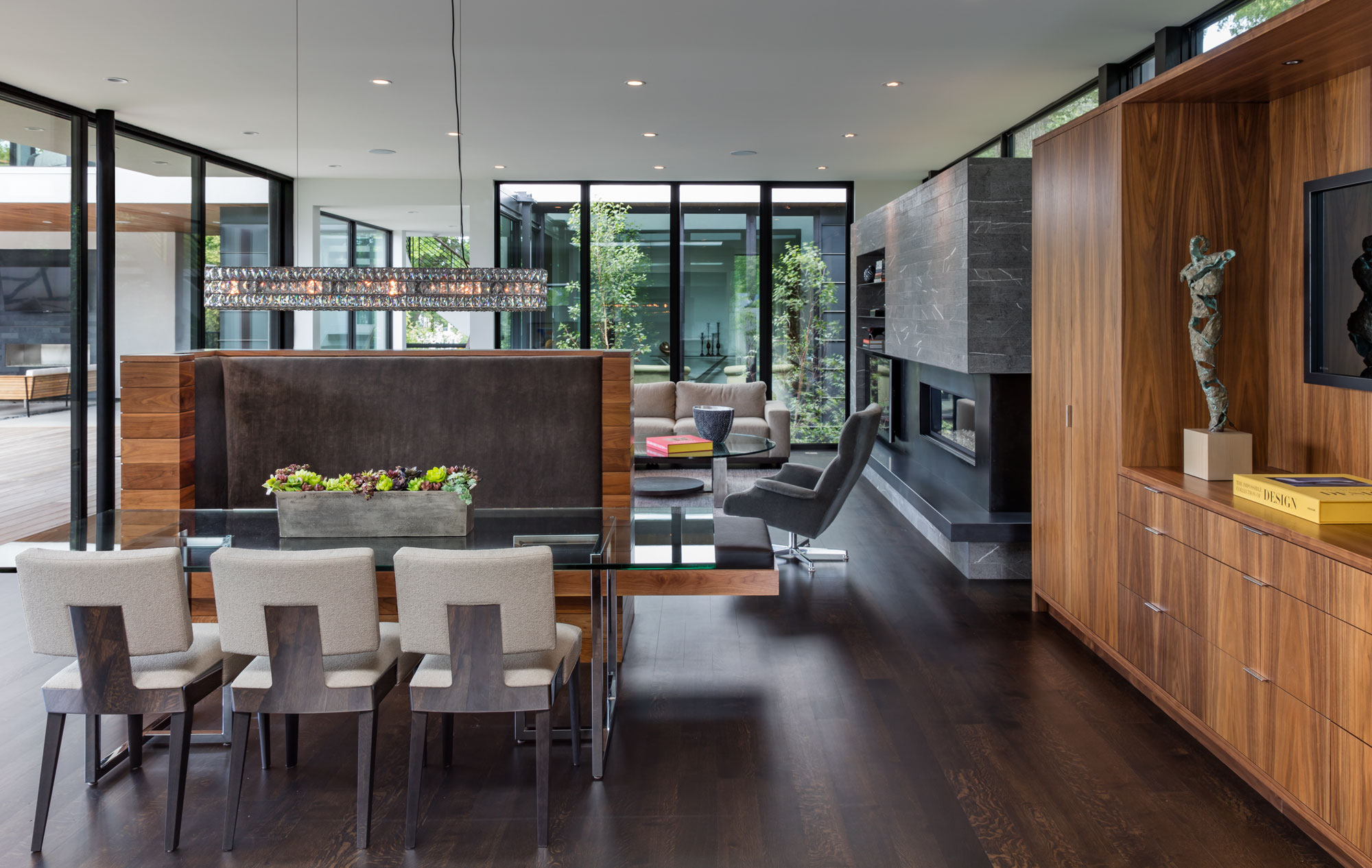
Photo by Paul Crosby
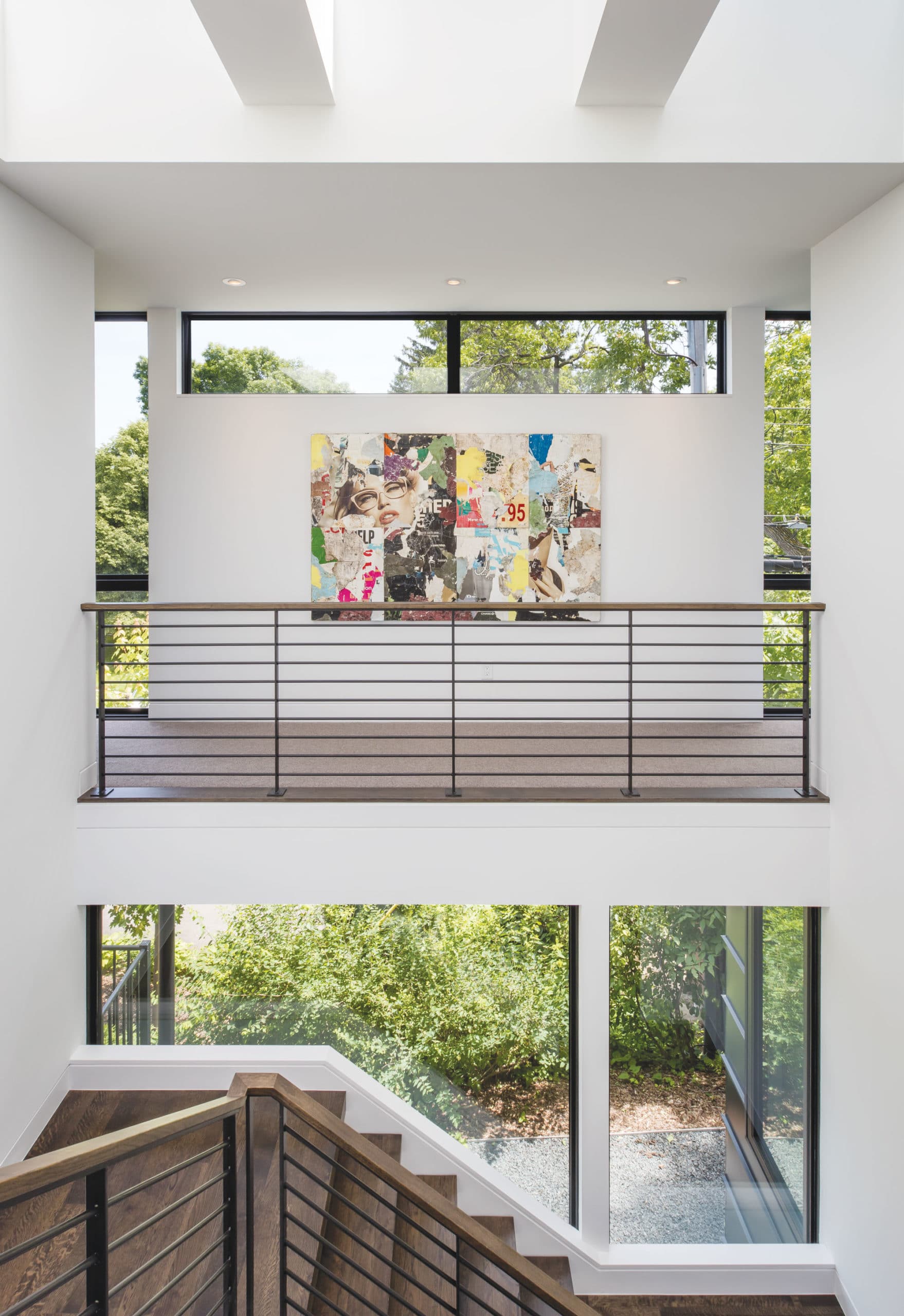
Photo by Paul Crosby
To connect the pavilions to the outdoors and one another, Peterssen/Keller used large expanses of glass, taking advantage of Western Window Systems’ ability to deliver thermally broken aluminum windows—they feature an extra layer of insulation that is definitely needed in chilly Minnesota—that stretch from wall to wall and from floor to 10-foot ceiling. The glass creates a relationship between the indoors and outdoors and visually connects the pavilions to one another. “It’s indoor space bleeding into outdoor space that bleeds back into indoor space,” says Gabriel Keller, a principal at Peterssen/Keller. “So there’s this incredible continuity.”
This being Minnesota, the designers freely invited light into the home to take advantage of passive heating and create a sense of warmth and brightness during the cold months. “In the north, we treasure the limited sunlight we receive through our long winters,” Keller says. On the building’s southern side, existing deciduous trees filter sunlight during the warm summer months. In a place like Minnesota, which experiences all four seasons to the max, this is a flexible alternative to installing overhangs for shade. After all, those are static throughout the year. A tree’s leaves fall as the temperature cools; in the summer, the trees provide shade, in the winter, sunlight penetrates. That means the home is able to incorporate vast expanses of glass, without worrying about overheating in the summer because of direct sun on the southern side. The northern exposure, where the sun is less intense, doesn’t make use of shade trees, and several large windows let in cool, even northern light all year long. “It is about as close to Johnson’s Glass House as we can get here in Minnesota and still stay comfortable,” Keller says.
Michigan Modern
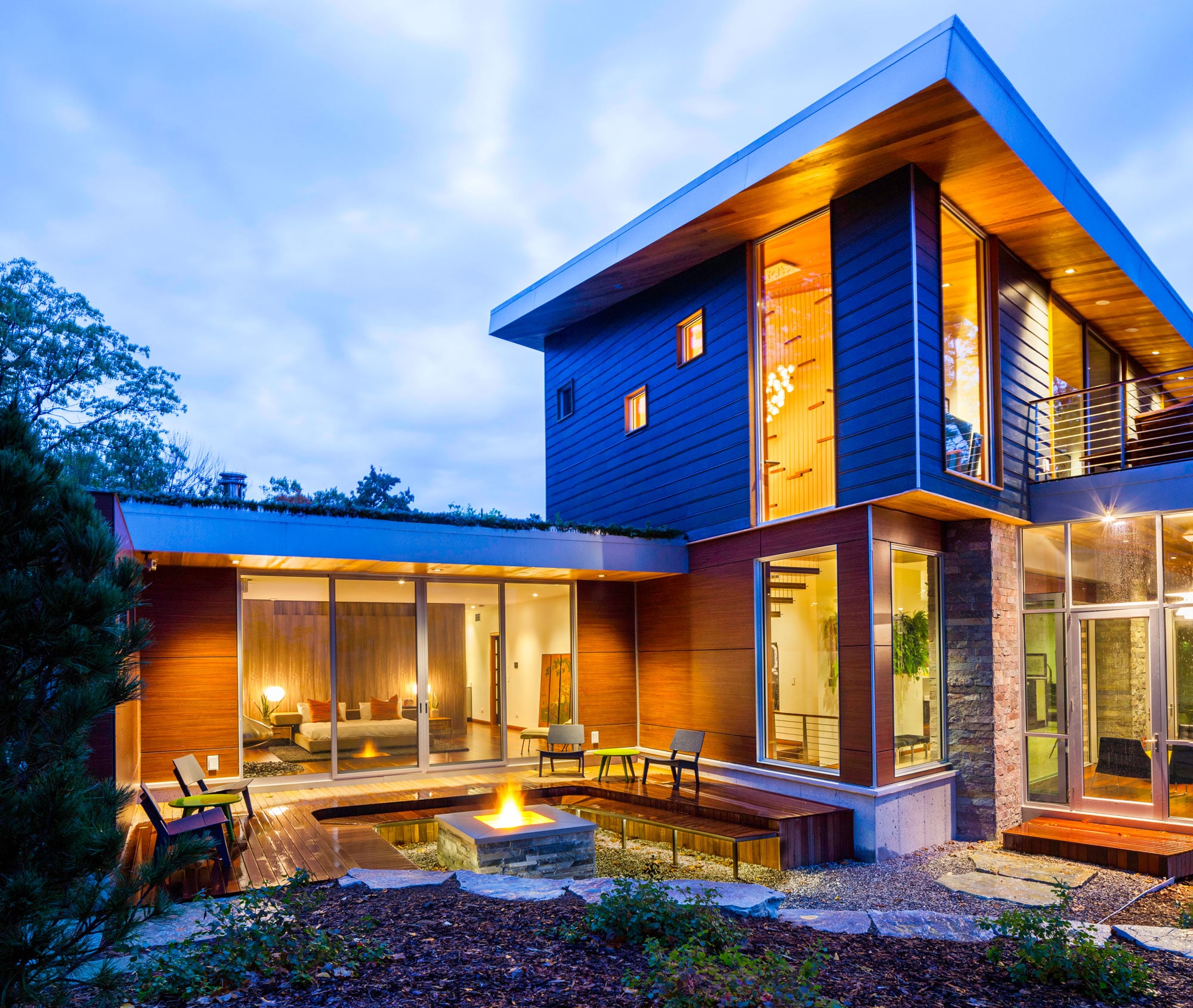
Strategically placed windows give the M-22 House plenty of light and unbeatable views. Photo by Dietrich Floeter
Michael Fitzhugh is a Michigan native, but he left the state to study architecture and work in Salt Lake City and San Francisco. In 2004, he moved home to found his firm, Michael Fitzhugh Architect, and work on his lifelong dream: bringing contemporary design to northern Michigan. The area isn’t known for such design, partly because the cold weather and high winds traditionally haven’t been considered compatible with a contemporary aesthetic that includes walls upon walls of windows. Wouldn’t it be too hard to heat such a building efficiently?
But things are changing, in no small part because of advances in window technology. When Fitzhugh designed the M-22 House on Lake Michigan in 2013, he was able to incorporate expansive windows and still meet energy standards, thanks to Western Window Systems’ tight, durable weatherstripping and dual-paned, triple-coated low-E glass, which helps block the transfer of heat. The result is a modern residence that uses rainwater, geothermal water, and gravity to generate power for the house and takes advantage of the sun’s energy for passive heating to ensure it’s as efficient as possible.
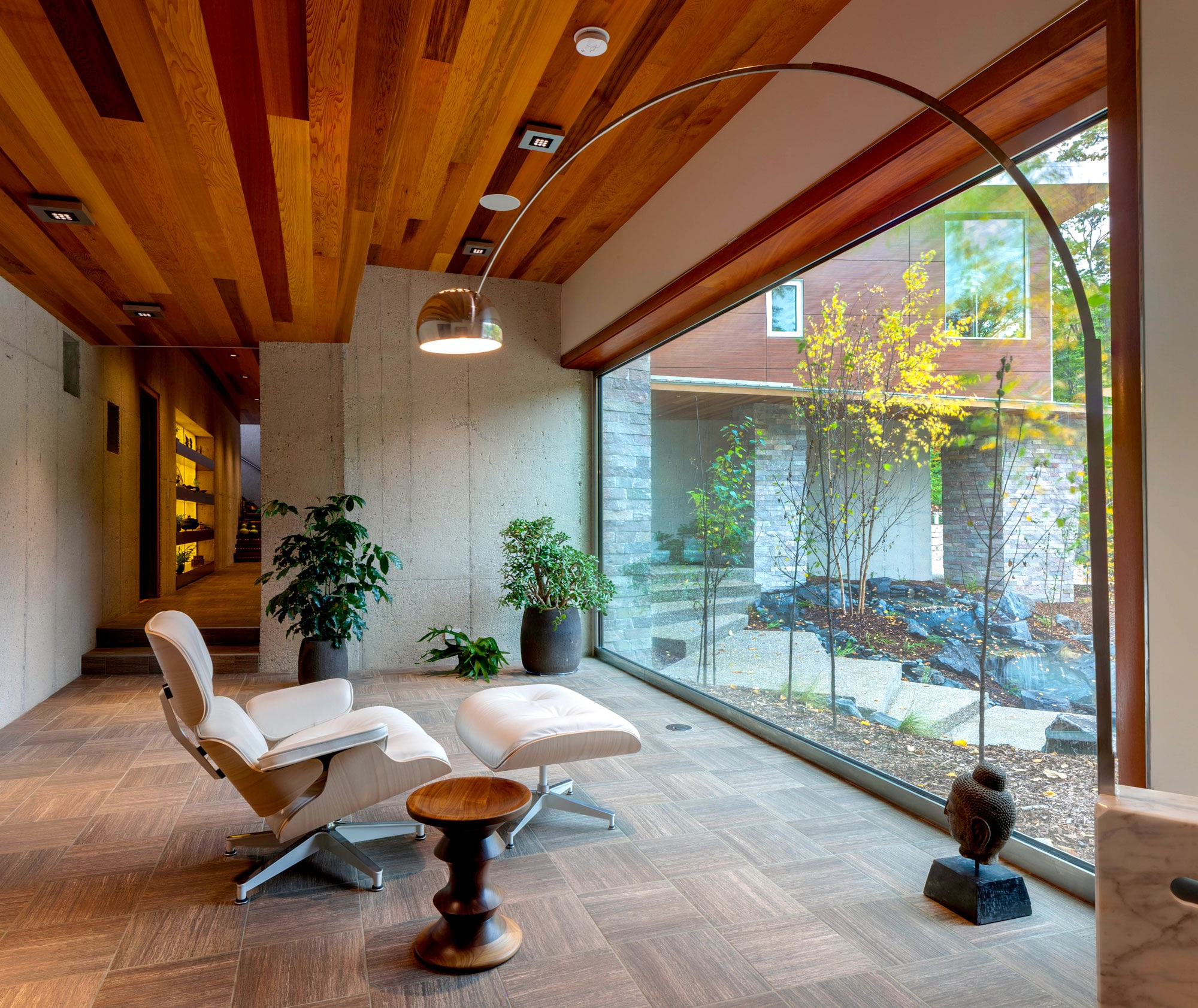
Photo by Dietrich Floeter
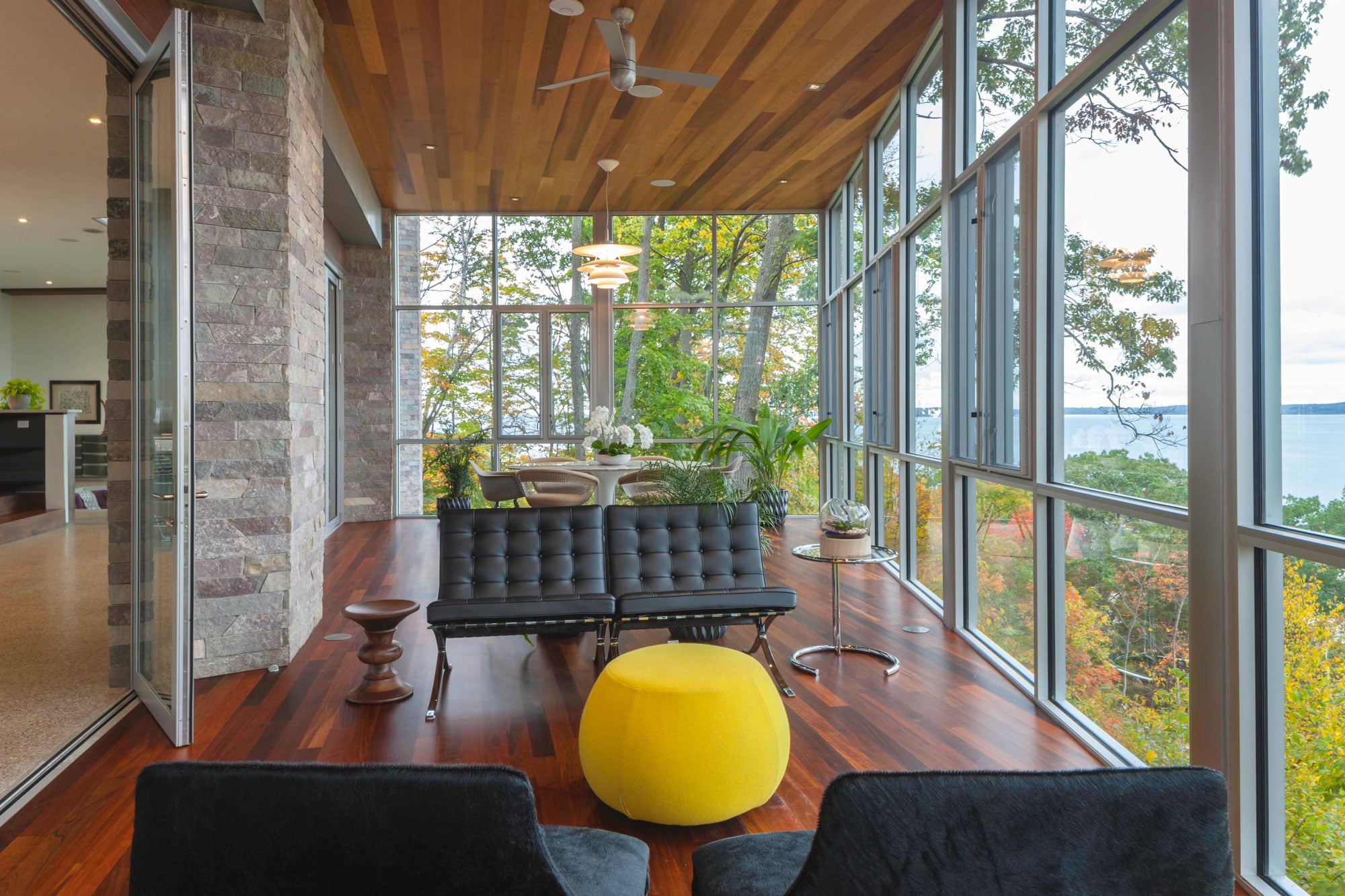
Photo by Dietrich Floeter
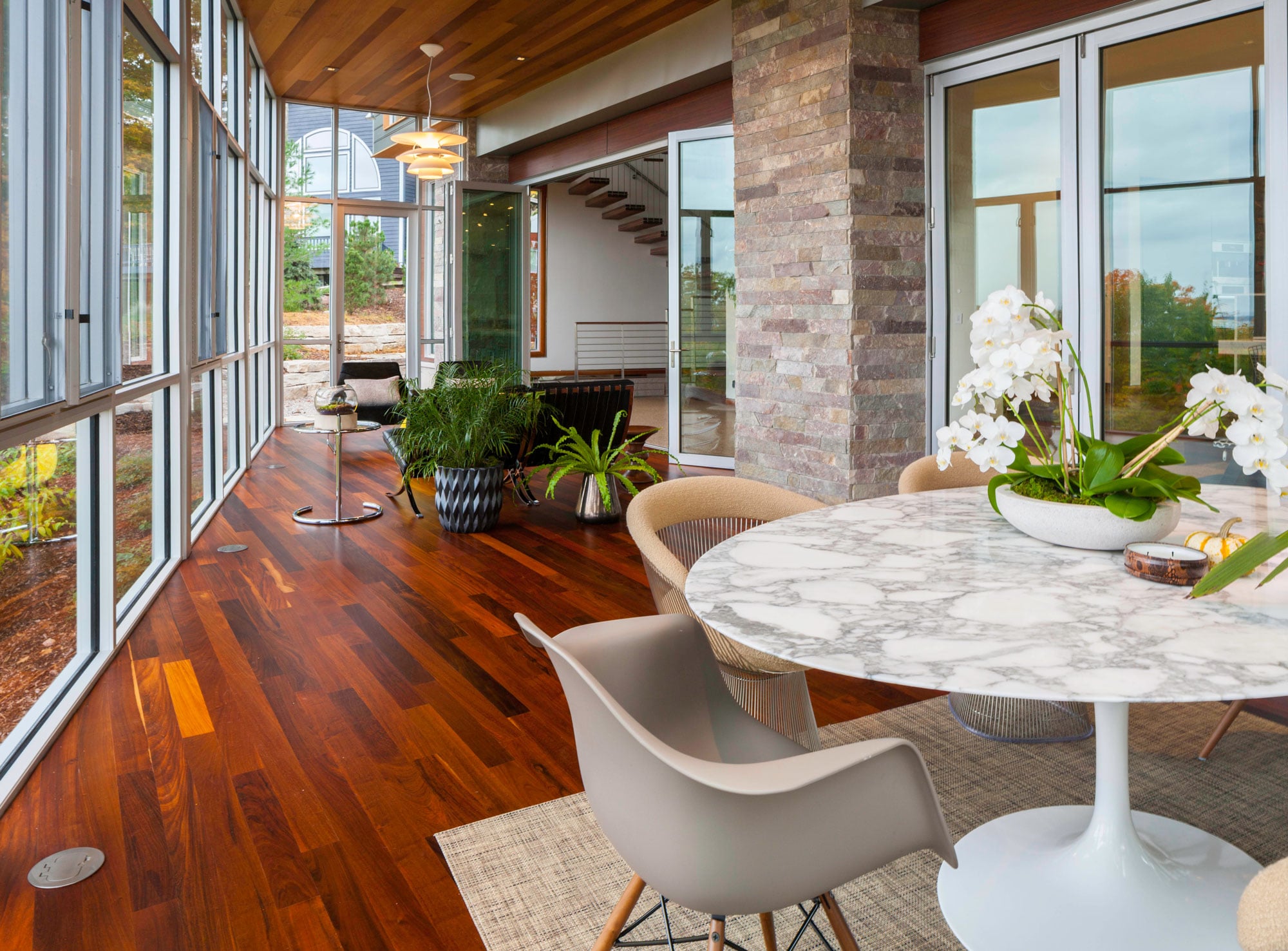
Photo by Dietrich Floeter
The M-22 House is perched on a tall ridge overlooking Lake Michigan with an extraordinary view of West Grand Traverse Bay to the east. Fitzhugh wanted to use windows for two purposes: to show off those views and to bring plenty of light into the home. Obviously, he wanted to place windows on the eastern side, where the lake is, but eastern exposures offer uneven lighting—a lot of light in the morning, not enough light in the afternoon. And on the plot’s southern side, where there’s an abundance of sunlight throughout the day, there were few opportunities for big windows—the only view is of the nearest neighbor.
This is where Fitzhugh’s thoughtful, site-specific approach came into play. “Light comes in many forms,” he says. “It’s not about having a lot of windows; it’s about having strategically placed windows.” Throughout the house, Fitzhugh made small, thoughtful decisions to draw sun into the home, like placing a small window at the end of a hallway, so the corridor doesn’t end in a dark corner, but with a pool of light. To add a thermal layer between a large window wall and the outdoors, the home has a glass three-season sun room. In the spring, summer, and fall, the room acts as additional living space. In the winter, it insulates the rest of the home from the frigid temperatures.
The kitchen has two long, narrow windows running practically the length of the room. When you stand at the kitchen stove and look out, you have a view, unobstructed even at the periphery. “You can go to a window and look out straight ahead, but it’s like you’ve got blinders on either side,” Fitzhugh says. “Having that uninterrupted panoramic is what makes it really special.”
West Texas Exposure

Large sheets of glass, overhangs, and well placed windows abound at the Franklin Mountain House. Photo by Casey Dunn
For the Tucson-based architecture firm Hazelbaker Rush, light is important from a psychological standpoint. “We are creatures that instinctively respond to the daily cycles of the sun,” says co-owner Dale Rush. “It’s imperative to allow the natural light into our homes and to let it dictate our schedule and inform our rhythms.” But sunlight also serves a pragmatic purpose: It’s one part of an arsenal of strategies used to reduce a building’s energy consumption. The Franklin Mountain House, 800 feet above El Paso, is no different, even if the harsh desert climate complicates things a bit. In the dazzling desert light of West Texas, taking advantage of the sun for passive heating—without turning a home into a hotbox—is tricky. But with some creative thinking, it can be done.
Many of the Franklin Mountain House’s windows are lined with overhangs—Rush calls them “eyebrows”—to block direct light from the high summer sun. But in winter, when the sun sits low in the sky, the rays penetrate, heating the polished concrete floors. The floors then act as a thermal mass, storing energy during the day and releasing it at night as the temperature drops. Many rooms are entirely illuminated by sunlight during much of the day, meaning there’s rarely any need for the overhead LED lights. The living room and kitchen, for example, are lit through the Western Window Systems Series 600 Multi-Slide Door, which, Rush notes, stands up uniquely well to the dust and rocks invariably blown by the desert wind into its tracks, plus the scorpions, centipedes, vinegaroons, and other pests that “are constantly testing the perimeter,” he says. “The weatherstripping Western Window Systems uses does a good job of keeping the wilds of the desert on the outside.”
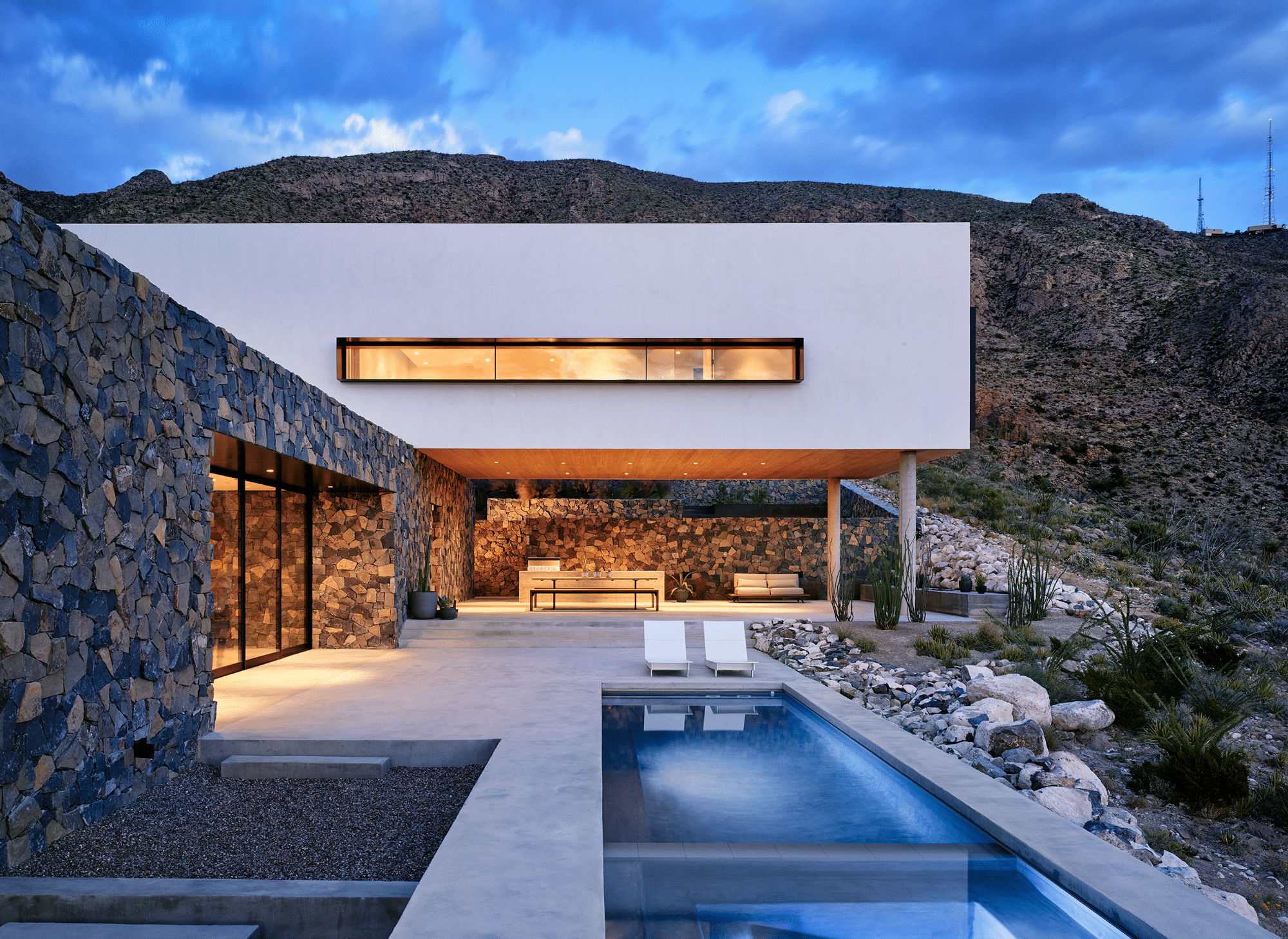
Photo by Casey Dunn

Photo by Casey Dunn

Photo by Casey Dunn
The home sits on a steep hill and is arranged in three stacked volumes, with each level maintaining a direct connection with the earth and expansive windows forging a link to the outdoors. The few rooms where light isn’t desirable, like the wine room and the living room, sit back against the hill, while all the bedrooms face east, so you wake with the sun. The windows in the living room and kitchen face south but are flanked with an 8-inch overhang to temper the glaring desert light. In the upstairs hallway is the sole west-facing window. It’s set in a particularly deep eyebrow to protect it for most of the day, but around 3 p.m., the sun edges into just the right spot, pouring in direct light. To cut down on solar heat gain, that opening is covered with a roll-down shade programmed to drop every afternoon and retract in the evening, just in time to show off the sunset.
The home is surrounded by gorgeous, unobstructed desert vistas. To ensure the purest views possible, Rush took advantage of large, undivided sheets of glass from Western Window Systems. In the upstairs hallway, for example, there’s a wall-to-wall, floor-to-ceiling window that “makes it feel as if you could walk down the hallway and dive off into the canyon to the south,” he says. “The kids will press themselves up against the glass and the interior of the house disappears from view, and they are floating 20 to 30 feet above the desert, eye to eye with red-tailed hawks or golden eagles gracefully riding the thermals up the canyon.”

